The
properties of a high-strength concrete-mix with a compressive strength
of more than 40 MPa is greatly influenced by the properties of
aggregates in addition to that of the water-cement ratio. To achieve
high strength, it is necessary to use lowest possible water-cement
ratio, which invariably affects the workability of the mix and
necessitates the use of special vibration techniques for proper
compaction. In the present state of art, a concrete with a desired 28
day compressive strength of upto 70 MPa can be made with suitably
proportioning the ingredients using normal vibration techniques for
compacting the concrete mix.
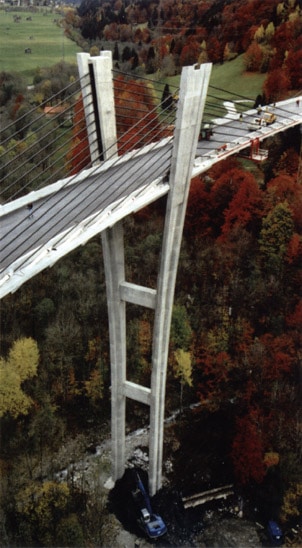 Erntroy and Shacklock’s Empirical Graphs:
Erntroy and Shacklock have suggested empirical graphs relating the
compressive strength to an arbitrary ‘reference number’ for concrete
made with crushed granite, coarse aggregates and irregular gravel. These
graphs are shown in figure 1 and 2 for mixes with ordinary Portland
cement and in figure 3 and 4 for mixes with rapid hardening Portland
cement. The relation between water cement ratio and the reference number
for 20mm and 10mm maximum size aggregates is shown in figure 5, in
which four different degrees of workability are considered. The range of
the degrees of workability varying from extremely low to high
corresponds to the compacting factor values of 0.65 and 0.95
respectively
Erntroy and Shacklock’s Empirical Graphs:
Erntroy and Shacklock have suggested empirical graphs relating the
compressive strength to an arbitrary ‘reference number’ for concrete
made with crushed granite, coarse aggregates and irregular gravel. These
graphs are shown in figure 1 and 2 for mixes with ordinary Portland
cement and in figure 3 and 4 for mixes with rapid hardening Portland
cement. The relation between water cement ratio and the reference number
for 20mm and 10mm maximum size aggregates is shown in figure 5, in
which four different degrees of workability are considered. The range of
the degrees of workability varying from extremely low to high
corresponds to the compacting factor values of 0.65 and 0.95
respectively
The relation between the aggregate-cement and water-cement ratios, to achieve the desired degree of workability with a given type and maximum size of aggregate are compiled in table-1 and 2 for two different types of cements. The limitations of these design tables being that they were obtained with aggregates containing 30 percent of the material passing the 4.75 mm IS sieve. Thus, if other ingredients are used suitable adjustments have to be made. Aggregates available at site may be suitably combined by the graphical method to satisfy the above requirement. In view of the considerable variations in the properties of aggregates, it is generally recommended that trial mixes must first be made and suitable adjustments in grading and mix proportions effected to achieve the desired results.
Table
– 1: Aggregate cement ratio (by weight) required to give four degrees
of workability with different water –cement ratios using ordinary
Portland cement
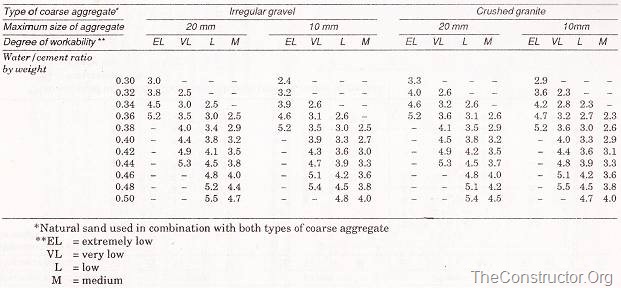
Table – 2: Aggregate cement ratio (by weight) required to give four degrees of workability with different water –cement ratios using rapid hardening cement
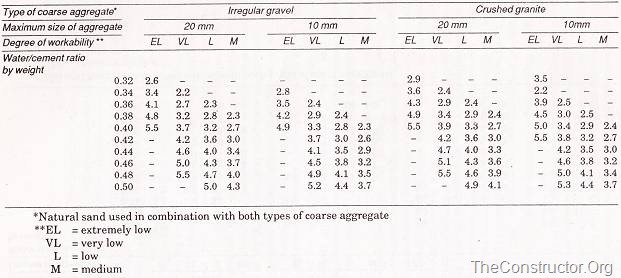
MIX DESIGN PROCEDURE:

Fig.1: Relation between compressive strength and reference number (Erntroy and Shacklock)
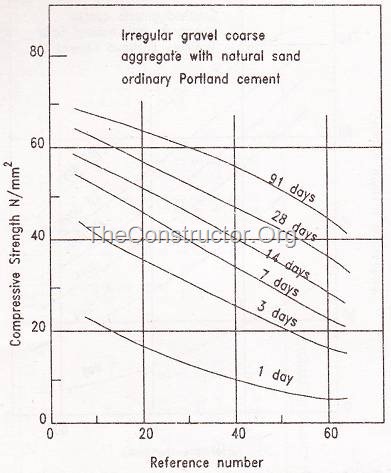
Fig-2: between compressive strength and reference number (Erntroy and Shacklock)

Fig-3: Relation between compressive strength and reference number (Erntroy and Shacklock)
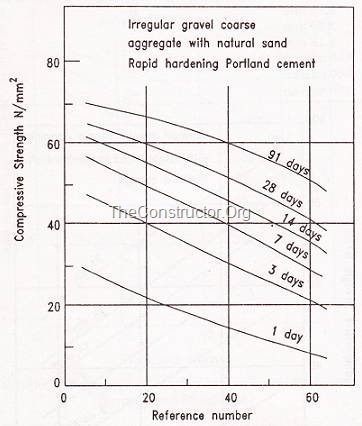
Fig-4: Relation between compressive strength and reference number (Erntroy and Shacklock)
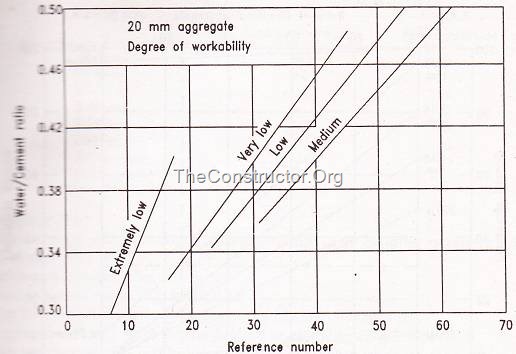
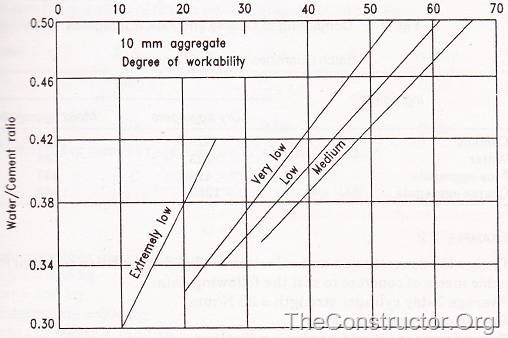
Fig-5: Relation between water-cement ratio and Reference Number
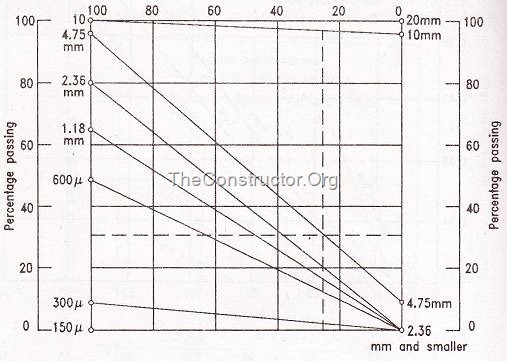
Fig-6: Combining of Fine aggregates and Coarse aggregates
Table – 3: Batch Quantities per cubic metre of concrete

MIX DESIGN EXAMPLE
Design a high strength concrete for use in the production of precast prestressed concrete to suit the following requirements:
Specified 28-day works cube strength = 50 MPa
Very good degree of control; control factor = 0.80
Degree of workability = very low
Type of cement = ordinary Portland cement
Type of coarse aggregate = crushed granite (angular) of maximum size 10mm.
Type of fine aggregate = natural sand
Specific gravity of sand = 2.60
Specific gravity of cement = 3.15
Specific gravity of coarse aggregates = 2.50
Fine and coarse aggregates contain 5 and 1 percent moisture respectively and have grading characteristics as detailed as follows:
DESIGN OF MIX
Mean strength = (50 / 0.80) = 63 MPa
Reference number (fig.1)= 25
Water cement ratio (fig 5) = 0.35
For a 10mm maximum size aggregate and very low workability, the aggregate-cement ratio for the desired workability (table-1) =3.2
The aggregates are combined by the graphical method as shown in figure 6, so that 30 percent of the material passes through the 4.75 mm IS sieve.
Ratio of fine to total aggregate = 25%
Required proportions by weight of dry materials:
Cement – 1
Fine aggregates – [(25/100)x3.2] = 0.8
Coarse aggregates – [(75/100)x3.2)] = 2.4
Water = 0.35
If C = weight of cement required per cubic meter of concrete, then



The relation between the aggregate-cement and water-cement ratios, to achieve the desired degree of workability with a given type and maximum size of aggregate are compiled in table-1 and 2 for two different types of cements. The limitations of these design tables being that they were obtained with aggregates containing 30 percent of the material passing the 4.75 mm IS sieve. Thus, if other ingredients are used suitable adjustments have to be made. Aggregates available at site may be suitably combined by the graphical method to satisfy the above requirement. In view of the considerable variations in the properties of aggregates, it is generally recommended that trial mixes must first be made and suitable adjustments in grading and mix proportions effected to achieve the desired results.

Table – 2: Aggregate cement ratio (by weight) required to give four degrees of workability with different water –cement ratios using rapid hardening cement

MIX DESIGN PROCEDURE:
- The mean design strength is obtained by applying suitable control factors to the specified minimum strength.
- For a given type of cement and aggregates used, the reference number corresponding to the design strength at a particular age is interpolated from figure 1 to 4.
- The water-cement ratio to achieve the required workability and corresponding to the reference number is obtained from figure 5 for aggregates with maximum sizes of 20mm and 10mm.
- The aggregate-cement ratio to give the desired workability with the known water cement is obtained by absolute volume method.
- Batch quantities are worked out after adjustments for moisture content in the aggregates.

Fig.1: Relation between compressive strength and reference number (Erntroy and Shacklock)

Fig-2: between compressive strength and reference number (Erntroy and Shacklock)

Fig-3: Relation between compressive strength and reference number (Erntroy and Shacklock)

Fig-4: Relation between compressive strength and reference number (Erntroy and Shacklock)


Fig-5: Relation between water-cement ratio and Reference Number

Fig-6: Combining of Fine aggregates and Coarse aggregates
Table – 3: Batch Quantities per cubic metre of concrete

MIX DESIGN EXAMPLE
Design a high strength concrete for use in the production of precast prestressed concrete to suit the following requirements:
Specified 28-day works cube strength = 50 MPa
Very good degree of control; control factor = 0.80
Degree of workability = very low
Type of cement = ordinary Portland cement
Type of coarse aggregate = crushed granite (angular) of maximum size 10mm.
Type of fine aggregate = natural sand
Specific gravity of sand = 2.60
Specific gravity of cement = 3.15
Specific gravity of coarse aggregates = 2.50
Fine and coarse aggregates contain 5 and 1 percent moisture respectively and have grading characteristics as detailed as follows:
IS sieve size
|
Percentage Passing
| |
Coarse aggregate
|
Fine aggregate
| |
20mm
|
100
|
–
|
10mm
|
96
|
100
|
4.75mm
|
8
|
98
|
2.36mm
|
–
|
80
|
1.18mm
|
–
|
65
|
600 micron
|
–
|
50
|
300 micron
|
10
| |
150 micron
|
–
|
0
|
DESIGN OF MIX
Mean strength = (50 / 0.80) = 63 MPa
Reference number (fig.1)= 25
Water cement ratio (fig 5) = 0.35
For a 10mm maximum size aggregate and very low workability, the aggregate-cement ratio for the desired workability (table-1) =3.2
The aggregates are combined by the graphical method as shown in figure 6, so that 30 percent of the material passes through the 4.75 mm IS sieve.
Ratio of fine to total aggregate = 25%
Required proportions by weight of dry materials:
Cement – 1
Fine aggregates – [(25/100)x3.2] = 0.8
Coarse aggregates – [(75/100)x3.2)] = 2.4
Water = 0.35
If C = weight of cement required per cubic meter of concrete, then
For information regarding Specific Gravity of Cement read:
ReplyDeleteSpecific Gravity of Cement- Details and Test Procedure